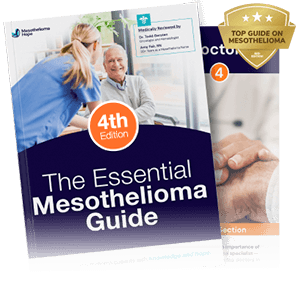Do Brake Pads Have Asbestos?
Yes, asbestos was used in brake pads and other materials for much of the 20th century.
Brake pads work by applying friction pressure on a spinning brake disc or inside a brake drum. Asbestos helped keep the pads working under this pressure and prevented them from overheating.
However, as brake pads wore down over time, they released asbestos fibers into the air. Mechanics who worked with or around brake pads could breathe in these fibers, which could trigger cancers like mesothelioma later in life.
Key Facts on Asbestos in Brake Pads
- Products: Asbestos brake liner, brake pads, brake drums, brake housings, and disc brake systems
- Used in: Cars, planes, trains, machinery, propellers, and anchor systems
- Health risks: Mesothelioma, lung cancer, asbestosis, and other diseases
- Manufacturers: Ford, John Deere, National Friction, Raybestos, and many more
- Compensation options: Mesothelioma lawsuits, asbestos trust fund claims, and veterans benefits through the U.S. Department of Veterans Affairs (VA)
Mesothelioma Hope can help you or a loved one find specialized medical care and pursue compensation if you got sick from brake pads with asbestos.
Get our Free Mesothelioma Guide now to explore your options.
Why Was Asbestos Used in Brake Pads?
Since asbestos was a naturally durable and friction-resistant material, it was considered ideal for brake components. It was also cheaper to use asbestos compared to alternatives.
Mechanics and other blue-collar workers didn’t know that asbestos in brake pads was harmful. Manufacturers of asbestos-containing products knew the dangers as early as the 1930s but hid them to keep making money.
By the time the public learned that asbestos could lead to mesothelioma, thousands of mechanics and millions of workers had already been exposed.
Even though the U.S. Environmental Protection Agency (EPA) finally banned the use of asbestos in brake pads in March 2024, there’s no way to lower your risk of getting sick once you’ve been exposed to this toxic mineral.
Who Is At Risk of Asbestos Exposure From Brake Pads?
Anyone who worked with or around brake pads that contained asbestos could be in danger of mesothelioma today.
Occupations at the highest risk of asbestos exposure from brake pads include:
- Aircraft mechanics
- Assembly line workers
- Auto mechanics
- Construction workers
- Factory workers
- Hobbyists
- U.S. Air Force veterans

While working as a mechanic, Art Putt sanded down and installed brakes with asbestos on a daily basis. “We had dust everywhere,” he recalls. “We didn’t know any better.” Decades later, Art was diagnosed with mesothelioma and given a year or less to live. Thankfully, after receiving treatment, Art is still alive today, more than 6 years later.
Family members also risked secondary asbestos exposure because mechanics and other workers could bring home fibers and dust on their clothing, hair, or skin after working on brake pads.
Asbestos brake pads may still be present on older vehicles, putting modern-day workers in harm’s way if proper precautions aren’t taken.
Health Risks of Asbestos in Brake Pads
Asbestos in brake pads can be linked to many serious illnesses, including cancer.
Notable asbestos-related diseases include:
- Mesothelioma: This cancer is only caused by asbestos exposure and develops in the lining of major organs.
- Lung cancer: Asbestos can damage the lungs and lead to cancer.
- Asbestosis: This noncancerous but potentially life-threatening illness causes the lungs to stiffen over time.
- Other illnesses: Asbestos exposure may lead to laryngeal cancer, ovarian cancer, and other dangerous health problems.
These health issues can appear 10 to 50 years after exposure to brake pads with asbestos.
Call (866) 608-8933 now if you or a loved one was exposed to asbestos in brake pads and now has mesothelioma. We’re here to help you access treatments and financial compensation.
Types of Asbestos Brake Pad Products
Multiple types of brake materials may contain asbestos. Learn about the most common products below.
- Asbestos Brake Linings
Usually attached to either brake pads or shoes, asbestos brake lining materials create friction in order to help a car slow down or stop. - Brake Pads
Used in disc brake systems to apply friction and pressure against rotors, which slows vehicles down. - Shoe Linings
Designed to be disposable but still prevent friction, these were also attached to brake shoes or pads. They may wear down faster than other pads or linings. - Other Materials
Insulation, clutches, gaskets, wiring, and cables used around or near brake pads could have relied on asbestos.
Working with or around these brake pad products could release asbestos fibers into the air, putting mechanics and anyone else in the area at risk of mesothelioma later in life.
Companies That Made Asbestos Brake Pads
Numerous companies made asbestos brakes, brake pads, and other materials.
Some of these asbestos companies companies included:
- Arnold Industries
- Caterpillar Inc.
- Ford Motor Co.
- John Deere Industrial Equipment Co.
- Montgomery Ward and Co.
- National Friction Products Corp.
- North American Rockwell Corp.
- Raybestos
These companies hid the health dangers of asbestos for decades, putting profits ahead of workers’ health.

John Panza developed mesothelioma through secondhand asbestos exposure. His father worked with brake pads made by National Friction Products and would come home covered in asbestos dust.
John has become a long-term mesothelioma survivor thanks to treatment. “I keep going,” said John. “And I continue to enjoy travel, music, teaching, and writing.”
Compensation for Victims of Asbestos in Brake Pads
You can pursue financial compensation if you or a loved one got sick from asbestos-containing materials like brake pads. Mesothelioma compensation can help cover the costs of treatment and protect your family’s financial future.
Notable ways to seek compensation include:
- Mesothelioma lawsuits: The average mesothelioma lawsuit awards $1 million or more. This compensation comes from companies that made and sold the asbestos car brakes and brake pads you were exposed to.
- Asbestos trust fund claims: There’s over $30 billion available in asbestos trust funds, which were set up by bankrupt companies to avoid lawsuits. Trust fund claims allow you to access some of this money without going to court.
- VA benefits: U.S. veterans who developed mesothelioma from asbestos in brake pads or other materials can access VA benefits, such as nearly $4,000 a month in disability payouts and free or inexpensive cancer treatments from military hospitals.
Mesothelioma Hope’s legal partners do all the work involved with lawsuits or trust fund claims for you, making the process much easier.
Learn whether you’re eligible for compensation during a Free Case Review.
Get Help After Exposure to Asbestos in Brake Pads
Mechanics and other workers risked exposure to asbestos in brake pads for decades, not knowing that they could develop mesothelioma later in life.
While mesothelioma and other asbestos-related diseases are life-threatening, our team stands ready to assist you and your family.
Mesothelioma Hope can help you:
- Connect with top doctors and treatments
- Determine when, where, and how you were exposed to asbestos
- Get the support you need to cope after a diagnosis
- Pursue justice and financial compensation
Call (866) 608-8933 or get our Free Mesothelioma Guide now to explore all of the resources available to you.
Brake Pads With Asbestos FAQs
Is asbestos still used in brake pads?
Yes. While brake pads with asbestos are no longer made in the U.S., vehicles built before the 1980s may still have them. Aftermarket brake products made in countries that still use asbestos, like China and India, are also common.
The Occupational Safety and Health Administration (OSHA) advises that anyone working on brakes assume they contain asbestos and take the proper safety precautions.
Can you get asbestos from brake dust?
Yes, you may be exposed to asbestos in brake dust. Brake shop dust contained an average of 33% asbestos fibers, according to a U.S. Environmental Protection Agency (EPA) study.
Mechanic and U.S. veteran Art Putt remembered dust constantly being released while working on asbestos brakes. Decades later, Art developed pleural mesothelioma (cancer of the lung lining).
Contact us if you worked with brake pads and now have mesothelioma or another asbestos-related illness. We can help you pursue treatments, compensation, and supportive care.
When was asbestos last used in brakes?
Asbestos was last used in American-made brakes in the 1980s. However, brakes, brake pads, and other materials are still made with asbestos internationally today.
Also, many older vehicles may still contain asbestos in brakes and brake pads.
What car parts have asbestos?
Brakes, brake pads, gaskets, insulation, clutches, and many other car parts were made with asbestos before the risks became public knowledge in the early 1980s.
We can help you access treatments and pursue financial compensation if you’ve developed mesothelioma from working with car parts. Call our team at (866) 608-8933 to get started.
How to tell if brake pads have asbestos?
You won’t be able to tell if brake pads have asbestos, according to the EPA.
If you think brake pads or other components may have asbestos, don’t touch them. Take the vehicle to an experienced mechanic to determine the next steps.
What replaced asbestos in brake pads?
Manufacturers replaced asbestos in brake pads with non-asbestos organic compound (NAO) materials. NAO brake pads contain fibers of copper, glass, and aromatic polyamide (aramid).
NAO brake pads offer many of the same benefits as asbestos brake pads, but they are not considered carcinogenic (cancer-causing).


 Get a Free Mesothelioma Case Review
Get a Free Mesothelioma Case Review




